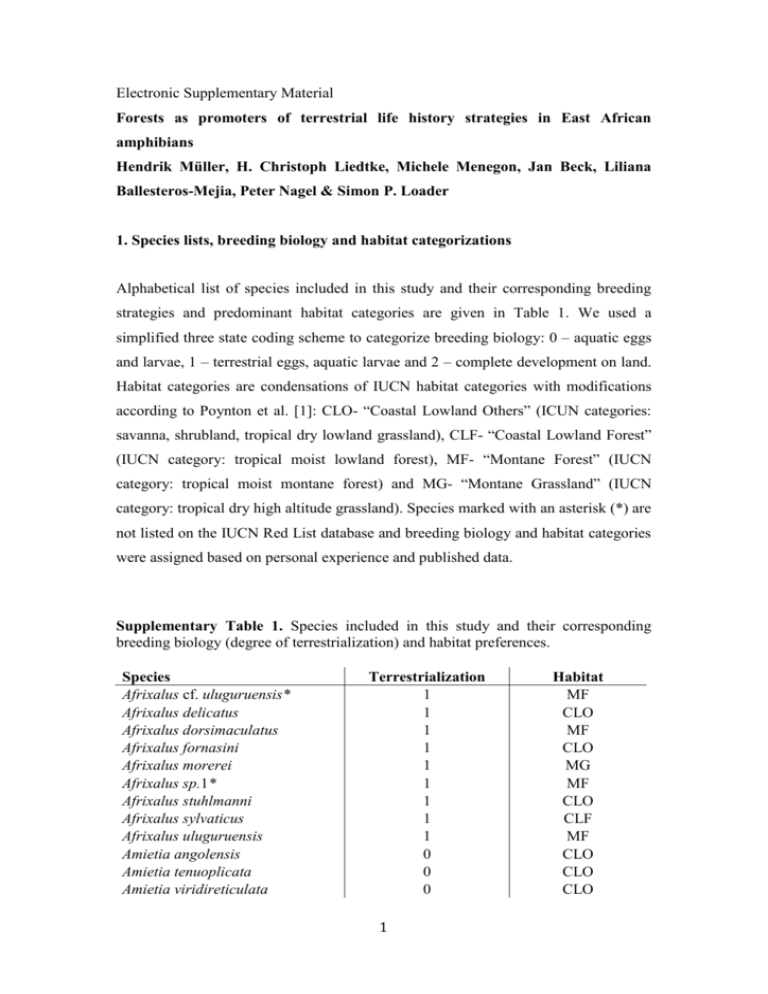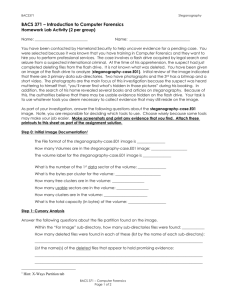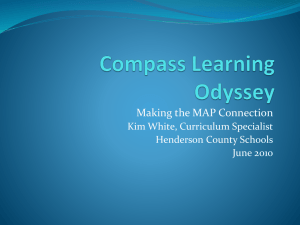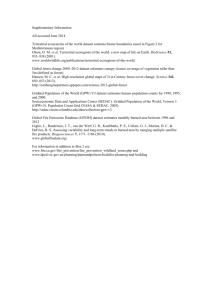Electronic Supplementary Material Forests as promoters of terrestrial
advertisement

Electronic Supplementary Material Forests as promoters of terrestrial life history strategies in East African amphibians Hendrik Müller, H. Christoph Liedtke, Michele Menegon, Jan Beck, Liliana Ballesteros-Mejia, Peter Nagel & Simon P. Loader 1. Species lists, breeding biology and habitat categorizations Alphabetical list of species included in this study and their corresponding breeding strategies and predominant habitat categories are given in Table 1. We used a simplified three state coding scheme to categorize breeding biology: 0 – aquatic eggs and larvae, 1 – terrestrial eggs, aquatic larvae and 2 – complete development on land. Habitat categories are condensations of IUCN habitat categories with modifications according to Poynton et al. [1]: CLO- “Coastal Lowland Others” (ICUN categories: savanna, shrubland, tropical dry lowland grassland), CLF- “Coastal Lowland Forest” (IUCN category: tropical moist lowland forest), MF- “Montane Forest” (IUCN category: tropical moist montane forest) and MG- “Montane Grassland” (IUCN category: tropical dry high altitude grassland). Species marked with an asterisk (*) are not listed on the IUCN Red List database and breeding biology and habitat categories were assigned based on personal experience and published data. Supplementary Table 1. Species included in this study and their corresponding breeding biology (degree of terrestrialization) and habitat preferences. Species Afrixalus cf. uluguruensis* Afrixalus delicatus Afrixalus dorsimaculatus Afrixalus fornasini Afrixalus morerei Afrixalus sp.1* Afrixalus stuhlmanni Afrixalus sylvaticus Afrixalus uluguruensis Amietia angolensis Amietia tenuoplicata Amietia viridireticulata Terrestrialization 1 1 1 1 1 1 1 1 1 0 0 0 1 Habitat MF CLO MF CLO MG MF CLO CLF MF CLO CLO CLO Amietophrynus brauni Amietophrynus garmani Amietophrynus gutturalis Amietophrynus maculatus Amietophrynus reesi Amietophrynus xeros Arthroleptis affinis Arthroleptis anotis* Arthroleptis cf. fichika* Arthroleptis cf. xenodactyloides* Arthroleptis fichika Arthroleptis kidogo* Arthroleptis lonnbergi Arthroleptis nguruensis* Arthroleptis nikeae Arthroleptis reichei Arthroleptis sp. 1* Arthroleptis sp. 2* Arthroleptis stenodactylus Arthroleptis stridens Arthroleptis tanneri Arthroleptis xenodactyloides Arthroleptis xenodactylus Boulengerula boulengeri Boulengerula cf. boulengeri* Boulengerula cf. ulugurensis* Boulengerula changamwensis Boulengerula niedeni Boulengerula taitanus Boulengerula uluguruensis Breviceps fichus Breviceps mossambicus Callulina dawida* Callulina hanseni* Callulina kanga* Callulina kisiwamsitu Callulina kreffti Callulina laphami Callulina shengena Callulina meteora* Callulina sp. 2* Callulina sp.1* Callulina stanleyi* Chiromantis kelleri Chiromantis petersii Chiromantis xerampelina 0 0 0 0 0 0 2 2 2 2 2 2 2 2 2 2 2 2 2 2 2 2 2 2 2 2 2 2 2 2 2 2 2 2 2 2 2 2 2 2 2 2 2 1 1 1 2 MF CLO CLO CLO CLO CLO MF MF MF MF MF MF CLO MF MF MF MF MF CLO CLO MF CLF MF MF MF MF CLF MF MF MF MG CLO MF MF MF MF MF MF MF MF MF CLF MF CLO CLO CLO Churamiti maridadi Hemisus marmoratus Hildebrandtia macrotympanum Hildebrandtia ornata Hoplophryne cf. rogersi* Hoplophryne cf. uluguruensis* Hoplophryne rogersi Hoplophryne sp. 1* Hoplophryne uluguruensis Hylarana galamensis Hyperolius argus Hyperolius cf. puncticulatus* Hyperolius glandicolor Hyperolius kihangensis Hyperolius mariae Hyperolius minutissimus Hyperolius mitchelli Hyperolius nasutus Hyperolius parkeri Hyperolius pictus Hyperolius pseudargus Hyperolius puncticulatus Hyperolius pusillus Hyperolius reesi Hyperolius rubrovermiculatus Hyperolius sp. 1* Hyperolius sp. 2* Hyperolius spinigularis Hyperolius tanneri Hyperolius tuberilinguis Hyperolius viridiflavus Kassina maculata Kassina senegalensis Kassina somalica Leptopelis argenteus Leptopelis barbouri Leptopelis bocagii Leptopelis cf. barbouri* Leptopelis cf. uluguruensis* Leptopelis concolor Leptopelis flavomaculatus Leptopelis parbocagii Leptopelis parkeri Leptopelis uluguruensis Leptopelis vermiculatus Mertensophryne (S.) loveridgei NA 1 0 0 1 1 1 1 1 0 0 1 0 NA 0 0 1 0 1 1 0 1 0 0 1 NA NA 1 NA 1 0 0 0 0 1 1 1 1 1 1 1 1 1 1 1 0 3 MF CLO CLO CLO MF MF MF MF MF CLO CLO MF CLO MF CLO CLO CLF CLO CLO MG MG CLO CLO CLO CLF CLO MF MF MF CLO CLO CLO CLO CLO CLO MF CLO MF MF CLO CLF CLO MF MF MF CLF Mertensophryne (S.) usambarae Mertensophryne lindneri Mertensophryne micranotis Mertensophryne taitana Mertensophryne uzunguensis Nectophrynoides asperginis Nectophrynoides cryptus Nectophrynoides frontierei Nectophrynoides laevis Nectophrynoides laticeps Nectophrynoides minutus Nectophrynoides paulae Nectophrynoides poyntoni Nectophrynoides pseudotornieri Nectophrynoides sp. 1* Nectophrynoides sp. 2* Nectophrynoides sp. 3* Nectophrynoides sp. 4* Nectophrynoides sp. 5* Nectophrynoides sp. 6* Nectophrynoides sp. 7* Nectophrynoides tornieri Nectophrynoides vestergaardi Nectophrynoides viviparus Nectophrynoides wendyae Parhoplophryne usambarica Petropedetes cf. yakusini* Petropedetes martiensseni Petropedetes yakusini Phlyctimantis keithae Phrynobatrachus acridoides Phrynobatrachus breviceps Phrynobatrachus krefftii Phrynobatrachus mababiensis Phrynobatrachus natalensis Phrynobatrachus pallidus Phrynobatrachus parvulus Phrynobatrachus rungwensis Phrynobatrachus scheffleri Phrynobatrachus sp. 1* Phrynobatrachus ukingensis Phrynobatrachus uzungwensis Phrynomantis bifasciatus Probreviceps cf. durirostris* Probreviceps durirostris Probreviceps loveridgei 0 0 0 0 NA 2 2 2 2 2 2 2 2 2 2 2 2 2 2 2 2 2 2 2 2 NA 1 1 1 0 0 0 1 0 0 0 0 0 0 0 0 0 0 2 2 2 4 CLF CLO CLF CLO MG MF MF MF MF MF MF MF MF MF MF MF MF MF MF MF MF MF MF MF MF MF MF MF MF MF CLO MG MF CLO CLO CLO MG MG CLO MG MG MF CLO MF MF MF Probreviceps macrodactylus Probreviceps rungwensis Probreviceps uluguruensis Ptychadena anchietae Ptychadena grandisonae Ptychadena mascareniensis Ptychadena mossambica Ptychadena oxyrhynchus Ptychadena porosissima Ptychadena schillukorum Ptychadena taenioscelis Ptychadena uzungwensis Pyxicephalus adspersus Pyxicephalus edulis Schismaderma carens Schistometopum gregorii Scolecomorphus cf. kirkii* Scolecomorphus cf. vittatus* Scolecomorphus kirkii Scolecomorphus sp.1* Scolecomorphus uluguruensis Scolecomorphus vittatus Spelaeophryne methneri Strongylopus fuelleborni Tomopterna cryptotis Tomopterna luganga Xenopus borealis Xenopus muelleri Xenopus petersii Xenopus victorianus 2 2 2 0 0 0 0 0 0 0 0 0 0 0 0 2 2 2 2 2 2 2 2 1 0 0 0 0 0 0 MF MF MF CLO MG CLO CLO CLO MG CLO CLO MG CLO CLO CLO CLO MF MF MF MF MF MF CLF MG CLO CLO MG CLO CLO CLO 2. Phylogenetic Analysis The comparative analysis outlined in this study required a species level phylogeny of East African amphibian species. However, for the majority of species included in this study (180 species; see Supplementary Table 1), molecular data remains unavailable. Using existing molecular data, we explored two different strategies for producing a comprehensive species level phylogeny of East African amphibians. Strategy 1 was to reconstruct a genus level phylogeny of East African amphibians using a mitochondrial and nuclear dataset. Species were added manually as a polytomy during the final tree reconstruction step. The advantage of this approach is a complete phylogeny, 5 although with unresolved nodes and equal branch lengths among species in each genus. While this strategy under-samples branch length differences among species, it provides a more accurate basis for analysing species across our study area. Strategy 2 was to utilize an existing phylogeny containing species that occur across the area and pruning out all species that do not inhabit the Eastern Arc Mountains and adjacent lowlands. This approach provides a better estimate of species level differences, but at the expense of completeness. Pyron and Wien [2] produced the most comprehensive analysis of amphibian relationships and we explored the suitability of this tree, pruned down to contain only East African taxa, to use in the comparative analyses here. Strategy 1: Complete East African Tree We compiled a data set for 33 amphibian ingroup species, including 30 frogs, and 3 caecilians using Genbank and previously published sequence data for the 16S rRNA and RAG1 genes (See Supplementary Table 2). The representative samples of each genus were not necessarily from specimens from the region. In two cases where there was an absence of one gene fragment for a species, we produced chimeric sequences for taxa using available sequences for presumably closely related taxa. Rag-1 sequences were not available for the following genera: Churamiti, Hildebrandtia, and Phlyctimantis. Based on previous studies, preliminary 16S trees, or BLAST searches, Churamiti shows closer relationships with Nectophrynoides, Hildebrandtia with Ptychadena, and Phlyctimantis with Kassina and Rag-1 data of these genera were used to form a chimeric sequence. In addition, analyses were conducted using alignments with missing data, rather than using chimeric sequences (e.g. for Churamiti, Hildebrandtia, and Phlyctimantis), to test how robust the phylogenies including and excluding such sequences were. No significant differences were noted. Parhoplophryne usambarica has not been collected since its original description [3] and data on its breeding biology and phylogenetic relationships are unknown. Therefore this taxon was excluded from all analyses. For phylogenetic inference we sampled one lepidosaur (Lacerta lepida) as an outgroup. The complete data set is a concatenation of one mitochondrial gene fragment (part of the 16S rRNA gene) and one nuclear protein-coding gene fragment (parts of Rag-1) totaling 1086 bp. Nucleotide sequences were aligned using MUSCLE [5] with default settings in the bioinformatics tool suite Geneious Pro 5.5.4 [6]. 6 Alignment ambiguities for the mitochondrial gene fragment were excluded using GBLOCKS version 0.19b [7] with default parameter settings for block selection (less stringent options were not selected). The resulting alignment is deposited in the Dryad repository: http://dx.doi.org/10.5061/dryad.8f74d [4]. For each gene partition, including codon position, the best-fit models of nucleotide substitution were identified using the Akaike information criterion (AIC;[8]) as implemented in Modeltest version 3.7 [9]. Best-fit models were estimated for each individual partition. The datasets were analysed using maximum likelihood (ML; [10]), and Bayesian inference (BI; [11]). Both analyses were run using a constraint to find the optimal tree shown in Pyron and Wiens [2], given that this represents the most comprehensive analysis of species level relationships across all amphibians. ML analyses were conducted with RAxML version 7.0.4 [12] using the rapid hill climbing algorithm [13]. BI used MrBayes version 3.2.1 [14] running four simultaneous Markov chains for 10 million generations, sampling every 1000 generations, and discarding the first one million generations as burn-in to prevent sampling before reaching stationarity. Two independent BI runs were performed to identify convergence. For both ML and BI analyses, model parameters were independently optimized for each partition (‘‘unlink’’ option in effect). Support for internal branches was evaluated by nonparametric bootstrapping [10] with 1000 replicates performed with RAxML (ML), and by posterior probabilities (BI). In order to produce a species level phylogeny for comparative analyses, all study species were inserted in appropriate genera with interrelationships unresolved in a polytomy. This phylogeny is also deposited in the Dryad Digital Repository as a newick file: http://dx.doi.org/10.5061/dryad.8f74d [4]. For the BayesTraits analysis, 100 permuted trees were generated with polytomies resolved to a branch length of 0.0001 in Mesquite v2.74 [15]. Strategy 2: Pyron and Wiens’ Tree The phylogeny presented by Pyron and Wiens [2] is currently the most comprehensive analysis of amphibian relationships. It includes data from 2871 species, with an average of 2563 base pairs per species. This tree was used as a basis for conducting comparative analyses. A single Maximum likelihood tree was made available from the authors. This tree was pruned using the R package “APE” [16], removing all taxa not included in our analysis. The resulting tree was then used as a 7 basis for conducting the comparative analyses. Supplementary Table 3 lists species coverage for both datasets (complete dataset and Pyron and Wiens data set). 8 Supplementary Table 2. African species used in the study with specimen-vouchers, localities, genbank accession numbers and origin. Species Voucher Geographic origin 16S rRNA RAG1 Origin Afrixalus dorsalis CAS 207523 Equatorial Guinea DQ347296 DQ347236 [17] Amietia angolensis VUB0992 Subsaharan Africa DQ347318 DQ347257 Genbank Amietophrynus brauni FMNH 251853 Tanzania AF220886 DQ158361 [17] Arthroleptis variabilis CAS 207822 Equatorial Guinea AY322263 AY364210 [17] Boulengerula boulengeri BMNH 2002.950 Tanzania EF107199 EF107322 [17] Breviceps mossambicus VUB 1031 Subsaharan Africa EF017947 EF018056 [17] Callulina kreftti TNHC 62491 Tanzania DQ347339 DQ347281 [17] Chiromantis rufescens CAS “143502” Subsaharan Africa GQ204724 GQ204605 Genbank Churamiti maridadi MTSN 5584 Tanzania FJ882769 EF107329 Genbank, RAG1 = EF107329 (N. tornieri) Hemisus marmoratus CAS 214843 Kenya AY364372 AY364216 Roelants, et al 2007 Hildebrandtia ornata “127641” Subsaharan Africa AF215402 DQ347245 Genbank, RAG1 = DQ347245 (Ptychadena spp) Hoplophryne rogersi MTSN 5158 Tanzania EF017961 EF018050 [17] Amnirana galamensis VUB 0996 Subsaharan Africa DQ347032 DQ347260 [17] Hyperolius sp. VUB 0924 Kenya AF249033 AY364208 [17] Kassina maculata “8414” Subsaharan Africa AF215444 AY571651 [17] Leptopelis kivuensis CAS 201700 Uganda AY322245 AY364211 [17] Mertensophryne micranotis BMNH 2002.343 Tanzania EF107207 EF107330 [17] Nectophrynoides tornieri BMNH 2005.1375 Tanzania EF107206 EF107329 [17] Parhoplophryne usambarica See MTSN 5158 Tanzania EF017961 EF018050 [17] (assumed close H. rogersi) Petropedetes cf. parkeri VUB 0955 Subsaharan Africa AY364369 AY364213 [17] Phlyctimantis leonardi DPL 4058 * DQ283356 * AY571651 Genbank, RAG1 = AY571651 (K. senegalensis) Phrynobatrachus kreffti VUB 1068 Tanzania DQ347342 DQ347284 [17] Phrynomantis bifasciatus VUB 0541 Subsaharan Africa AY948732 AY948918 [17] Probreviceps macrodactylus KMH 21399 Tanzania AY531875 KC632525 [18] 9 Ptychadena anchietae VUB 0958 Kenya DQ347307 DQ347245 [17] Pyxicephalus edulis BMNH 2002.438 Tanzania EF107211 EF107333 [17] Schismaderma carens MVZ 223386 Subsaharan Africa DQ158424 DQ158350 Genbank Schistometopum thomense BMNH 2000.301 Sao Tomé EF107204 EF107327 [17] Scolecomorphus vittatus CAS 168810 Tanzania EF107171 EF107294 [17] Spelaeophryne methneri FMNH 255879 Tanzania EF107167 EF107290 [17] Strongylopus grayi VUB 0991 Subsaharan Africa DQ347317 DQ347256 Genbank Tomopterna cf. natalensis ZFMK 68815 Rep. South Africa DQ347300 DQ347239 [17] Xenopus cf. muelleri VUB 0921 Kenya AY523771 AY523743 [17] 10 3. Comparative analysis 3.1 Details on comparative trait analysis Correlates of breeding strategy and habitat types were identified using a phylogenetic generalized least squares approach (pGLS; [19]), using the package APE [16] in R v.2.13.0 [20]. The regression model was constructed so as to test the effect of habitat as a categorical, explanatory variable on the breeding biology as the response variable, correcting for phylogenetic non-independence. Different models of evolution were implemented as error structures in three separate regressions, allowing traits to evolve via a Brownian Motion model, a Pagel’s λ model or an OrnsteinUhlenbeck model. AIC scores of each regression were compared and the best scoring model was considered the most appropriate (models with ΔAIC>2 were deemed as acceptable alternative models). Our coding system for the breeding biology of amphibians is based on two traits: environment of egg deposition and environment of larval development. To investigate whether the evolution of these two traits are affected differently by the environment, any habitat that was recovered to have a significant effect on the breeding strategy was carried forward and correlated evolution of habitat and terrestrial ovipositioning, and of habitat and terrestrial larval development was tested using the DISCRETE module in BayesTraits ([21]; available at http://www.evolution.rdg.ac.uk/). This software models the evolution of two binary traits across a given phylogeny, allowing traits to evolve either independently or dependent of each other. Both a Likelihood and Bayesian approach was used (see below for details). The log-likelihood scores and harmonic means for each of the two models were then compared to test for evidence of correlated evolution of traits. 100 trees with randomly resolved polytomies were generated in Mesquite [15] to average the effects of varying topologies. 25 optimization attempts were used in the likelihood analyses and significant improvements of the dependent over the independent model (or vice versa) were measured using a log-likelihood ratio statistic (2[(log-likelihood (dependent model) – log-likelihood (independent model))]), which follows a χ2 distribution with 4 degrees of freedom (calculated as the difference between the number of parameters between the two models, following Pagel [21]). 11 For the Markov chain Monte Carlo simulations, both models were run for 5 050 000 iterations, sampling every 100 chains, after a burn in period of 50 000 iterations. A reversible-jump hyperprior with a distribution of 0 to 30 was implemented, from which values to seed the exponential priors were drawn (rjhp exp 0 30; as recommended by the software authors) and the ratedev was adjusted to obtain acceptance rates between 20-40% [21]. A log-Bayes Factor (2log[harmonic mean (dependent model)] – log[harmonic mean (independent model)]) greater than 10 was considered as strong evidence in favour of one model over the other. A number of different datasets were used to test the robustness of our results as described in detail below. All datasets have been deposited in the Dryad repository: http://dx.doi.org/10.5061/dryad.8f74d [4]. 3.2 Comparison of data sets (strategies 1 and 2) Compared to the complete dataset containing all 180 species, the phyogeny based on Pyron and Wiens [2] contained only 73 taxa. These 73 taxa are not an accurate representation of the four different habitat categories, with a bias in favour of Coastal Lowland non-forest species, when compared to the 180 taxa of our dataset (see Supplementary Table 3). For instance, whereas 50% of the species of the full dataset are montane forest associated species, the dataset from Pyron and Wiens [2] contains only 34.2% montane forest species. The results of the pGLS and BayesTraits analyses using the full dataset (strategy 1) and the Pyron and Wiens data (strategy 2) were nonetheless broadly comparable. However, only montane forest was recovered as being significant using the Pyron and Wiens dataset, as opposed to montane and lowland forest in our dataset. Supplementary Table 3. Relative numbers and percentages of species included for main habitat categories. Pyron and Wiens [2] No. of species Full dataset using constrained tree Percentage of total number of species No. of species Percentage of total number of species CLO 42 57.5 64 35.6 CLF 3 4.1 11 6.1 12 MF 25 34.2 90 50.0 MG 3 4.1 15 8.3 Total 73 100 180 100 3.3 Results of the analyses of the full dataset (strategy 1) Phylogenetic generalized least-squares regression implementing a Pagel’s lambda model of evolution to test the effect of habitat on breeding biology coefficient ± SE t-value p-value 1.195 ± 0.700 0.259 ± 0.080 0.159 ± 0.048 0.025 ± 0.066 1.557 3.582 4.429 0.489 p=0.121 p<0.001 p<0.001 p=0.625 Pagel’s lambda model; λ= 0.984 Intercept Costal lowland forest Montane forest Montane grassland Correlated evolution of breeding strategy and habitat in BayesTraits-DISCRETE showing Log Likelihood scores and Harmonic Means for independent and dependent evolution of traits Log Likelihood Terrestrial egg – Montane forest Terrestrial egg – Coastal lowland forest Terrestrial larva – Montane forest Terrestrial larva – Coastal lowland forest Independent Dependent Likelihood Ratio -140.556 -122.445 36.221 -92.491 -87.029 -100.574 -52.509 MCMC Harmonic mean Independent Dependent Bayes Factor p<0.001 -145.416 -134.189 22.454 10.922 p<0.05 -104.587 -98.739 11.696 -94.318 12.512 p<0.05 -107.237 -108.125 -1.776 -52.432 0.154 p=0.997 -71.978 -69.916 4.125 p-value 3.4 Results of the analyses of the Pyron and Wiens [2] data set (strategy 2) Phylogenetic generalized least-squares regression implementing a Pagel’s lambda model of evolution to test the effect of habitat on breeding biology Pagel’s lambda model; λ= 1.000 Intercept Costal lowland forest Montane forest Montane grassland coefficient ± SE t-value p-value 0.862 ± 0.546 0.194 ± 0.229 0.390 ± 0.116 0.020 ± 0.201 1.579 0.847 3.353 0.099 p=0.119 p=0.400 p<0.05 p=0.921 Correlated evolution of breeding strategy and habitat in BayesTraits-DISCRETE showing Log Likelihood scores and Harmonic Means for independent and dependent evolution of traits Log Likelihood Terrestrial egg – Montane forest Terrestrial egg – Coastal lowland forest Independent Dependent Likelihood Ratio -60.979 -51.705 18.549 -37.893 -37.619 0.548 13 MCMC Harmonic mean Independent Dependent Bayes Factor p<0.001 -66.557 -60.829 11.454 p=0.969 -44.348 -44.074 0.549 p-value Terrestrial larva – Montane forest Terrestrial larva – Coastal lowland forest -50.026 -44.101 11.850 p<0.05 -56.690 -51.221 10.938 -26.940 -25.876 2.128 p=0.712 -30.374 -31.541 -2.333 3.5 Comparison of the results of the analyses of the different datasets (strategies 1 and 2) The overall similar results using the Pyron and Wiens tree as compared to our tree using a resolved, genus-level phylogenetic backbone with intrageneric polytomies shows that our phylogenetic approach is adequate for performing the comparative analyses. The one major difference is the lack of significance for lowland forest using the Pyron and Wiens dataset. A comparison of the datasets shows that the main difference between the two is essentially a greatly reduced number of species associated with lowland forests in the Pyron and Wiens dataset (3 vs. 11 in our original dataset; see Supplementary Table 3). The lack of significance for lowland forest for the Pyron and Wiens dataset is most likely a result of the diminished number of lowland forest species in the dataset. In general, there are fewer lowland forest associated species compared to the other habitat categories and this habitat is therefore particularly sensitive to a reduction in number of species in the analysis. Given that a comprehensive inclusion of terminals is more important for the comparative analyses than a fully resolved tree and seeing that the results recovered with the two datasets are comparable, we based our analyses on the full dataset instead of using the Pyron and Wiens tree. 3.6 Correcting for undescribed species and potential taxonomic inflation The complete data set of 180 species contains a number of not yet formally named taxa. The overwhelming majority of these undescribed and provisionally assigned species (all “sp.” and “cf.” taxa in Supplementary Table 1) originate from the forests of the Eastern Arc Mountains and most are characterized by derived reproductive modes. These species await taxonomic verification but based on current expert opinion are putative new species (candidate species sensu [22]). Because sampling in the region is probably biased towards montane habitats we investigated the robustness of our analyses to the high proportion of candidate species from montane forests compared to coastal lowlands and montane grasslands. This involved a re-analysis of 14 all data using the above approaches but with potential new species removed. This conservative approach to species diversity estimation indicated no significant differences in the pGLS results recovered from an analysis including all putative new species (see results table below). In contrast to the analysis on the full dataset, the correlation between terrestrial larval development and montane forest habitat lost strength slightly in the BayesTraits analysis when applying a Likelihood method (p=0.054). Similarly, the Baysian method could no longer recover a significant improvement of the dependent over the independent model of evolution for terrestrial egg deposition in association with Coastal Lowland Forest (BF=7.180). After removing candidate species the pGLS results continue to show a significant positive effect of both forest types on the occurrence of terrestrial breeding amphibians and the conclusions drawn from the BayesTraits analysis are comparable too: there is support for correlated evolution of terrestrial egg deposition predominantly with montane forest but also with coastal lowland forest. Although there is some indication of correlated evolution of terrestrial larval development and montane forest, this association is no longer statistically supported. Phylogenetic generalized least-squares regression implementing a Pagel’s lambda model of evolution to test the effect of habitat on breeding biology Pagel’s lambda model; λ= 0.981 Intercept Costal lowland forest Montane forest Montane grassland coefficient ± SE t-value p-value 1.204 ± 0.778 0.257 ± 0.082 0.227 ± 0.063 0.040 ± 0.069 1.547 3.133 3.611 0.575 p=0.124 p<0.05 p<0.001 p=0.566 Correlated evolution of breeding strategy and habitat in BayesTraits-DISCRETE showing Log Likelihood scores and Harmonic Means for independent and dependent evolution of traits Log Likelihood Terrestrial egg – Montane forest Terrestrial egg – Coastal lowland forest Terrestrial larva – Montane forest Terrestrial larva – Coastal lowland forest MCMC Harmonic mean Independen Dependent t Independent Dependent Likelihood Ratio -121.202 -108.468 25.469 p<0.001 -126.885 -118.146 17.478 -84.914 -80.013 9.802 p<0.05 -99.555 -95.965 7.180 -84.156 -79.515 9.281 p=0.054 -90.569 -93.368 -5.598 -47.868 -47.870 -0.005 p=1.000 -68.501 -66.581 3.840 15 p-value Bayes Factor 3.7 Influence of viviparous species Both viviparity and ovoviviparity are highly derived reproductive modes that are generally rare among amphibians [23]. Within East Africa the caecilian genera Scolecomorphus and Schistometopum contain viviparous species [24] and the bufonid Nectophrynoides species are ovoviviparous [23]. When looking at the taxonomic composition of lowland forest and non-forest habitats, montane forest, and montane grassland, it is apparent that viviparous and ovoviviparous species are predominantly found in montane forest. Especially Nectophrynoides represents a species-rich radiation of small bufonids nearly exclusively confined to the montane forests of the EAM. To test the influence that viviparous and ovoviviparous species might have on the analyses, we performed a separate pGLS and BayesTraits analysis excluding viviparous and ovoviviparous species from the dataset. Both montane and lowland forest habitats were again recovered as containing significantly more species with terrestrialized breeding strategies than the other habitat categories for the pGLS analysis. In comparison to the results when using the full dataset, the BayesTraits analysis no longer recovers a significant association for terrestrial larval development and montane forest (LR=6.056; p=0.195). Furthermore the MCMC method could no longer recover a significant improvement of the dependent over the independent model of evolution for terrestrial egg deposition in association with coastal lowland forest although the log Bayes Factor is only marginally below the significance threshold (BF=9.218). As is the case for the analyses using the conservative dataset (above), the pGLS and BayesTraits analysis suggest that even when removing the viviparous lineages, the general association of terrestrial breeding with forest habitat (especially montane forest) remains significant. However, no statistically significant support could be found for correlated evolution of terrestrial larval development and either forest habitat types. Given the relatively high number of viviparous and ovoviviparous species in the original dataset, the latter result is not surprising. Phylogenetic generalized least-squares regression implementing a Pagel’s lambda model of evolution to test the effect of habitat on breeding biology Pagel’s lambda model; λ= 0.969 Intercept Costal lowland forest Montane forest 16 coefficient ± SE t-value p-value 0.994 ± 0.676 0.256 ± 0.078 0.224 ± 0.057 1.470 3.259 3.957 p=0.144 p<0.05 p<0.001 Montane grassland 0.040 ± 0.067 0.601 p=0.549 Correlated evolution of breeding strategy and habitat in BayesTraits-DISCRETE showing Log Likelihood scores and Harmonic Means for independent and dependent evolution of traits Log Likelihood Terrestrial egg – Montane forest Terrestrial egg – Coastal lowland forest Terrestrial larva – Montane forest Terrestrial larva – Coastal lowland forest Independent Dependent Likelihood Ratio -130.676 -113.450 34.452 -88.566 -83.007 -89.472 -47.361 MCMC Harmonic mean Independent Dependent Bayes Factor p<0.001 -139.213 -126.319 25.788 11.117 p<0.05 -102.530 -97.921 9.218 -86.444 6.056 p=0.1950 -97.720 -98.569 -1.699 -46.838 1.046 p=0.9027 -66.991 -63.776 6.429 p-value References 1. Poynton J.C., Loader S.P., Sherratt E., Clarke B.T. 2007 Amphibian diversity in east african biodiversity hotspots: Altitudinal and latitudinal patterns. Biodivers Conserv 16(4), 1103-1118. (doi:10.1007/s10531-006-9074-1). 2. Pyron R.A., Wiens J.J. 2011 A large-scale phylogeny of Amphibia including over 2800 species, and a revised classification of extant frogs, salamanders, and caecilians. Mol Phylogenet Evol 61(2), 543-583. (doi:10.1016/j.ympev.2011.06.012). 3. Barbour T., Loveridge A. 1928 A comparative study of the herpetological faunae of the Uluguru and Usambara Mountains, Tanganyika Territory, with descriptions of new species. Memoirs of the Museum of Comparative Zoology 50, 85265. 4. Müller H., Liedtke H.C., Menegon M., Beck J., Ballesteros-Mejia L., Nagel P., Loader S.P. 2013 Data from: Forests as promoters of terrestrial life history strategies in East African amphibians. Dryad Digital Repository http://dx.doi.org/10.5061/dryad.8f74d. 5. Edgar R.C. 2004 MUSCLE: multiple sequence alignment with high accuracy and high throughput. Nucleic Acids Res 32(5), 1792-1797. (doi:10.1093/nar/gkh340). 6. Drummond A.J., Ashton B., Buxton S., Cheung M., Cooper A., Duran C., Field M., Heled J., Kearse M., Markowitz S., et al. 2012 Geneious v5.6. (Available from http://www.geneious.com. 7. Castresana J. 2000 Selection of Conserved Blocks from Multiple Alignments for Their Use in Phylogenetic Analysis. Molecular Biology and Evolution 17(4), 540552. 8. Akaike H. 1974 A new look at the statistical model identification. IEEE Transactions on Automatic Control 19, 716-723. 9. Posada D., Crandall K.A. 1998 Modeltest: Testing the model of DNA substitution. Bioinformatics 14, 817-818. 10. Felsenstein J. 1985 Confidence-limits on phylogenies - an approach using the bootstrap. Evolution 39, 783-791. 11. Huelsenbeck J.P., Ronquist F., Nielsen R., Bollback J.P. 2001 Bayesian Inference of Phylogeny and Its Impact on Evolutionary Biology. Science 294(5550), 2310-2314. (doi:10.1126/science.1065889). 17 12. Stamatakis A. 2006 RAxML-VI-HPC: maximum likelihood-based phylogenetic analyses with thousands of taxa and mixed models. Bioinformatics 22(21), 2688-2690. (doi:10.1093/bioinformatics/btl446). 13. Stamatakis A., Hoover P., Rougemont J. 2008 A Rapid Bootstrap Algorithm for the RAxML Web Servers. Systematic Biology 57(5), 758-771. (doi:10.1080/10635150802429642). 14. Ronquist F., Teslenko M., van der Mark P., Ayres D.L., Darling A., Höhna S., Larget B., Liu L., Suchard M.A., Huelsenbeck J.P. 2012 MrBayes 3.2: Efficient Bayesian Phylogenetic Inference and Model Choice across a Large Model Space. Systematic Biology. (doi:10.1093/sysbio/sys029). 15. Maddison W.P., Maddison D.R. 2010 Mesquite: A modular system for evolutionary analysis. Version 2.74. http://mesquiteproject.org. 16. Paradis E., Claude J., Strimmer K. 2004 APE: analyses of phylogenetics and evolution in R language. Bioinformatics 20, 289-290. 17. Roelants K., Gower D.J., Wilkinson M., Loader S.P., Biju S.D., Guillaume K., Moriau L., Bossuyt F. 2007 Global patterns of diversification in the history of modern amphibians. Proceedings of the National Academy of Sciences 104(3), 887-892. (doi:10.1073/pnas.0608378104). 18. Loader S.P., Poynton J.C., Mariaux J. 2004 Herpetofauna of Mahenge Mountain, Tanzania: a window on African biogeography. Afr Zool 39(1), 71-76. 19. Martins E.P., Hansen T.F. 1997 Phylogenies and the comparative method: a general approach to incorporating phylogenetic information into the analysis of interspecific data. Am Nat (149), 646-667. 20. R Core Team. 2012 R: a language and enviroment for statistical computing. R foundation for statistical computing. (http://www.R-project.org/). 21. Pagel M. 1994 Detecting correlated evolution on phylogenies: a general method for the comparative analysis of discrete characters. Proceedings of the Royal Society B - Biological Sciences 255, 37-45. 22. Vences M., Wake D. 2007 Speciation, species boundaries and phylogeography of amphibians. In Amphibian biology volume 7: Systematics (eds. Heatwole H., Tyler M.), p. 570, Surrey Beatty & Sons. 23. Wake M.H. 1978 The Reproductive Biology of Eleutherodactylus jasperi (Amphibia, Anura, Leptodactylidae), with Comments on the Evolution of LiveBearing Systems. Journal of Herpetology 12(2), 121-133. (doi:10.2307/1563398). 24. Wilkinson M., Nussbaum R.A. 2006 Phylogeny and classification of caecilians. In Reproductive biology and phylogeny of Gymnophiona (ed. Exbrayat J.M.), pp. 527-612. Enfield, Science Publishers. 18







